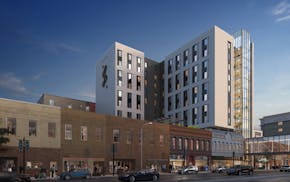Rochester's recently established downtown landmark district is facing its first major test as a local developer seeks to tear down three historic properties to make way for a modern housing tower.
Property owner Hal Henderson is pushing to remove the adjoining brick structures along South Broadway from the district, arguing that their deterioration makes further investment impractical.
He envisions replacing the buildings — now home to a record store, coffee shop and two art galleries — with a multistory development aimed at addressing the demand for student housing downtown.
"It's clearly obvious to everybody that these properties are not in a state where they're ready to serve our community for the next several decades or centuries," Henderson said. "They've served their purpose; it's time to turn the page."
However, preservation advocates see the proposal as a direct challenge to the district's purpose. They contend that the landmark designation was created specifically to shield historic properties from economic pressures that have already erased much of downtown's architectural heritage.
The three buildings along Broadway — all of which date back to establishment of the downtown commercial district in the 1880s — are among 27 properties contributing to the downtown historic district.
"This is a classic example of why we have the ordinance," said Rochester resident Barb Hudson. "Because we know that there are going to be people coming in to look at these landmarks and they're going to say, 'What can I do to make money?' But the fact is that these buildings are historic … and that's why they were landmarked."
The issue came to a head on Wednesday as the city's Heritage Preservation Commission (HPC) voted 6-0 to recommend denial of Henderson's request to have the buildings removed from the district.
The commission also denied the developer's ask for a certificate of appropriateness to alter the properties out of concern the proposal would negatively impact the character of the downtown district.
"Nothing was presented that anything has changed with either the historic significance or the integrity" of the properties, said Commissioner Anthony Poirier, adding that the developer also failed to prove financial hardship of maintaining the buildings.
In the lead-up to the review, Henderson had sought to find a compromise with the city that includes preserving the facades of two of the buildings. The remainder of the buildings would be demolished and replaced with a residential tower, glass elevator and a two-story gymnasium.
He estimated the development would cost in the ballpark of $40 million to $50 million.
Commissioner Stephanie Cunningham was the lone dissenting voice on the HPC, arguing that the city needs to find a balance when considering the economic impact of a new development.
"By halting this development solely on the grounds of historic preservation, we risk undermining the true purpose of preserving historic buildings," Cunningham said. "If a historic building stands empty due to high renovation costs and structural damage, how does this serve our community?"
While neither vote is legally binding, the HPC recommendations will make their way to the Rochester City Council, which has final say on any changes.
The district was adopted in early 2024 after more than a decade of debate on the topic. Following pushback over financial impacts to property owners, Destination Medical Center officials agreed to put $5 million toward renovations to buildings in the district.

Judge orders Minnesota cannabis agency to hold canceled license lottery after all

Indigenous activists clash with Minnesota GOP legislators over rights for wild rice
Watch: Driver charged with nearly hitting stopped school bus on snowy Minnesota highway
Inside President Trump's whirlwind decision to blow up global trade

